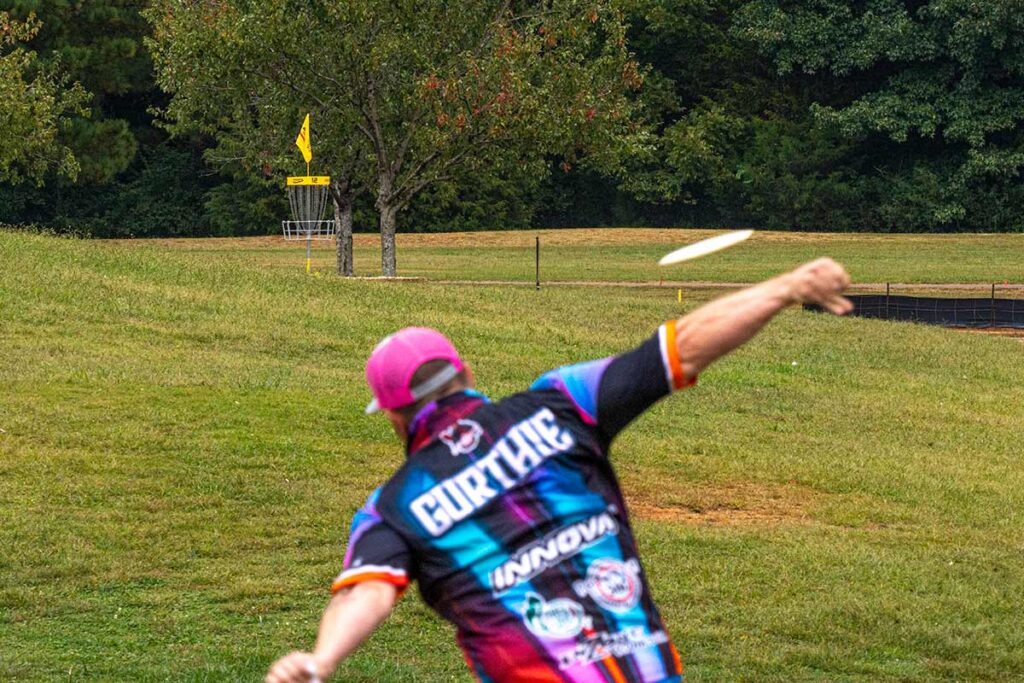Hyzer Vs. Anhyzer
When you first start playing disc golf, you will start to hear some unique terminology for our sport. Some terms might sound familiar, especially if you understand golf. Par, birdie, bogey, eagle, ace, fairway, OB—these all have the same meaning in every form of golf. Then, you have some unique words that you may have never heard before you picked up a disc.
“Hyzer” and “anhyzer” are probably the two that cause the most confusion among new disc golfers. We’re here to set the record straight and help you feel like you’ve been using these words your entire life!
If you watch any professional disc golf coverage on YouTube or the Disc Golf Network, you will undoubtedly hear the commentators using these two words a lot. The meanings behind both are actually quite simple. In the most basic sense, hyzer and anhyzer refer to the player’s angle of release.
What is a Hyzer?

Most new players will find that their discs tend to fade immediately to the left on a standard righty backhand throw. This is because they lack power and proper throwing form, or they are throwing discs that are too fast or too stable (meaning overstable) for their arm speeds. The release angle also has a lot to do with it. When a disc golf disc is thrown and curves sharply away from you, this is the basic premise behind a hyzer throw.
Experienced players will throw hyzers on purpose because they offer excellent control and predictability. They will take an overstable disc and release it on a sharp angle—with the disc tilted away from their body. This shot is used to get around obstacles or for very controlled shots. An overstable disc thrown on a hyzer will give you exceptional control because the flight pattern is very dependable with a left finish. Extreme examples of this throw would be known as “spike hyzers,” where the release angle and flight of the disc are on a sharp curve the entire way.
FYI: Innova created and popularized the four number flight rating system which has become ubiquitous to golf discs and the history of disc golf. All discs, even those made by different manufacturers, use the system to quickly explain how the disc behaves in the air.
“Hyzer” refers primarily to the angle of release more than just the disc’s flight angle. Skilled players can release the disc on a hyzer angle, but use a more understable disc (maybe even a putter or midrange with a lot of glide and less stability than an overstable distance driver). The disc comes out on angle, but flips up to flat and glides out for great distance and control. This throw is what’s known as a “hyzer flip.”
Many people who come from an Ultimate Frisbee background or are just used to playing catch in the park are naturally accustomed to hyzer throws. Those flying discs are generally very understable and will flip up and glide naturally when thrown on this kind of angle.
What is an Anhyzer?

This brings us to the other end of the spectrum and what we disc golfers call the “anhyzer” release. This is basically the opposite release angle of a hyzer. Rather than the disc tilting down and away from your body when you throw, it will be tilted upward (with your upper body being more upright or leaning back, as well). An anhyzer angle can often give you more distance as you get a full flight out of your distance drivers with an S-shaped flight path. It can also be useful for very technical shots when you want to shape a righty backhand throw from left to right with an understable disc. An extreme anhyzer release will even produce roller shots.
Players with good power and arm speed can utilize an anhyzer release with a very overstable disc. This would be called a “force flex” shot that produces a more controlled S-shape (also known as a “helix”) when you need to hit a tight wooded line or weave your disc through a winding fairway.
Though spike hyzers, hyzer flips, force flexes, and rollers are all very valuable tools to help improve your game, novice players will generally want to learn a flat release and how to throw the disc flatter in order to get more out of its flight. Once you master a flat throw, then you can experiment with more release angles and discs with different flight characteristics. As you get better, you can master various hyzer shots, flat shots, and anhyzer shots—all of which can be utilized effectively with both backhand and forehand (sidearm) throws.
Release angles are just one component of the game any disc golfer will need to work on as they refine their form and skills. Understanding the very basics of hyzer vs. anhyzer is a good place to start. Most importantly, you’ll know what people are talking about when you hear these unusual disc golf terms.
